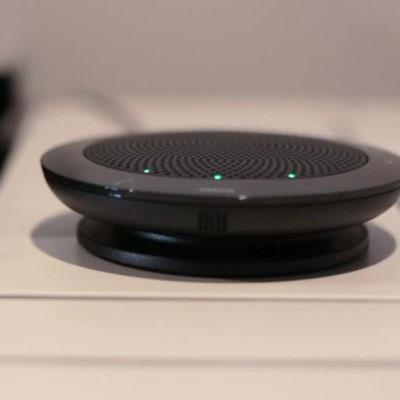Can You Hear Me Now? Xerox Gives Customers Voice Control Over Multifunction Printers

Xerox Wants Users To Get Gabi With Their Copiers
As the printer market gets ever more competitive, Xerox is hoping to stand out by offering voice control for some of its multi-function printers. Partnering with Gabi Solutions, the company has built a product using IBM's Watson voice recognition technology that lets users print, scan and email, and initiate service calls using their voice.
Xerox and Gabi said Watson was a better option than similar offerings from Amazon or Google for two reasons: First, it does not listen to conversations in the work place, and second, Watson offered them a palette of languages for users, which the competition could not match.
Gabi Voice is available on 10, mid-range, multi-function printer models at the moment, using the version of Xerox's Extensible Interface Platform, which is available only on AltaLink devices, the company said.
The following are excerps from interviews with Xerox and Gabi Solutions execuitves about their alliance and the new Xerox product.

What did Xerox hope to accomplish by adding Gabi Voice to its products?
Renee Carter, Mid Products Business Unit V.P., Workplace Solutions, Xerox: It was developed in part to … make devices in information technology available to all, to persons of all abilities. So there was a lot of focus on enabling for folks with visual impairments, varying disabilities and limited motor skills, and it's primarily focused on allowing them to copy, to scan to email, fax and do secure print, as well as placing a service call. That's the primary focus, but it's certainly usable by all others.
Sarah Vollo, Global Marketing Manager, Solutions and Apps Offerings, Workplace Solutions Business Group, Xerox: We see a lot of use cases in the government sector, but there's a lot of demand. We know how big voice recognition, voice command is now, so there is actually quite a bit of demand around it being able to talk to the MFP, and have that seamless interaction is really huge for a lot of companies, whether it's a small to medium business, or a large enterprise. So it's really seen across multiple areas here.

What happens when Gabi Voice initiates a call for service?
Luis J. Diaz, Esq. - General Counsel and Chief Cybersecurity Officer, Gabi Solutions: Five things that happen with one command. "Place a service call." Just those magic words invoke a series of steps that would otherwise involve multiple screens. What happens is the machine gathers a state of every single variable that's going on at that particular moment in time. That is appended to a report, that report is then emailed to the customer service rep that has been designated by the user to be the recipient of a tech support call. The user has the ability to speak, a message on top of it, explaining what the need for the support is. So there's five very complex things that independently would require multiple screens, typing on a little screen, [that] get replaced by a natural language interface that makes it faster and quicker.

Does Gabi Voice require a technician to install and what is the advantage for Xerox channel partners?
Carter: No it does not. It's customer installable. Gabi Solutions provides the information and the config sheet early on, before the device gets there that gets it paired to their MFP, so when the device actually shows up they should just hook it up and they're good to go.
They [channel partners] also deal with customers who have accessibility requirements for their users. And also the general value for users for productivity, as we discussed earlier. Also to add that to the plethora of offerings we have with our Xerox devices to demonstrate all of the innovation that we put in and offer, versus our competitors.

In terms of security, why did you choose to go with Watson over other products?
Diaz: The problem with Alexa, and we started with Alexa, is that you've seen the eavesdropping-related disasters that have happened already and those are going to create legal liability. In an enterprise environment, we can't afford that risk from a cyber security standpoint. So the architecture that our company developed has three components. There's the on-premise component where the wake word is purely local. You don't have to go to the cloud for anything that happens. On and off is right there on the actual smartbox. The second component is natural language processing. All that Watson really does is process language and one of the great things that Watson gave us was the ability to opt out of creating a digital footprint. So we do not store. All of the processing is encrypted and it's transient, meaning that none of it is stored by us, so there's no PII [personally identifiable information] capture in BIOS in the initial processing, and there is no PII that is captured by Watson, because we have the ability to opt out of sending the voice streams. Unfortunately, our friends at Amazon could not do that. And the other platforms do not do that. They basically save everything for different reasons. That was an essential architecture decision.

The other Watson capability that Xerox and Gabi found appealing is its ability to shift easily between multiple languages. Currently the device will only be available in English, but it has the capability to expand into Chinese, Arabic, Spanish, French and German.
Norm Sherman, Chief Technology Officer, Gabi Solutions: The multi-languages are a big topic and user request and Watson, out of the gate, supports eight major languages. And we have the opportunity to further enhance the solution by leveraging those languages in multiple ways. Having the user be able to speak in their native language [and] having the system respond in that native language is phenomenal without having the user specify any configuration flags or parameters to get that accomplished.
Diaz: The language was a huge consideration. Being able to rapidly deploy the solution in a multi-language format, across boundaries and borders, was essential in our thinking. For a multi-national company, the alternative is just not viable. So, in selecting the platform, to develop our solution, that was a key consideration.
Carter: I think other than just being multinational, even in the U.S., you have many folks using devices whose first language might not be English. In many organizations and facilities where they service the public, would be places where this would be of value as well.